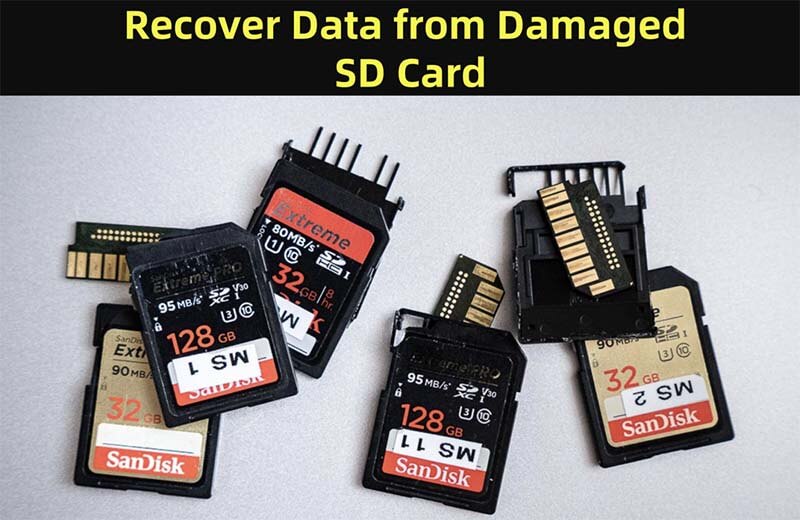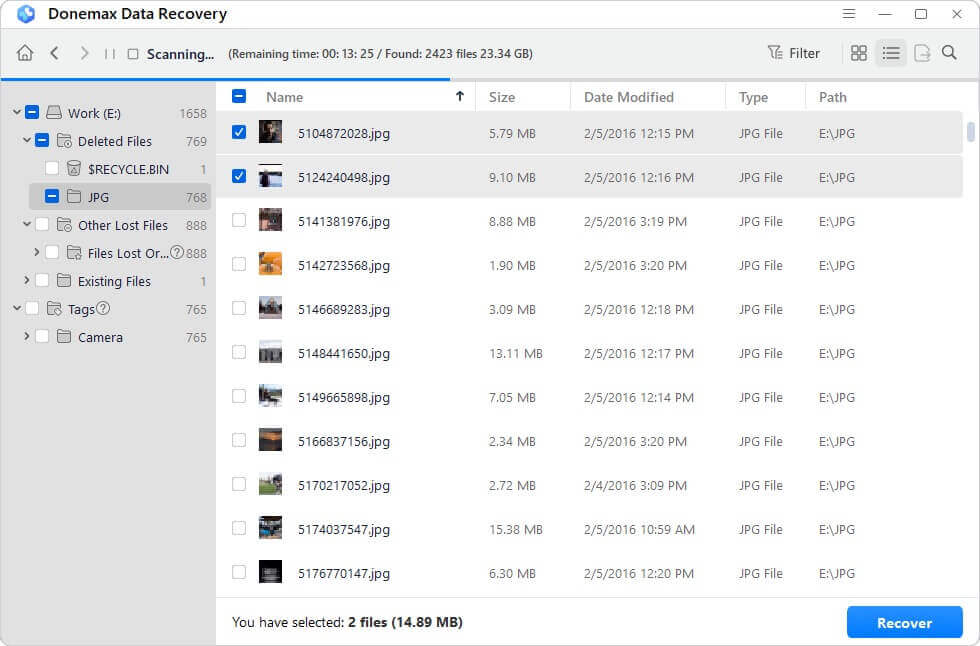Before we start: Donemax Data Recovery is a powerful SD card data recovery program. It not only can help you recover deleted/formatted or inaccessible data from a damaged SD card, but it also can help you repair damaged SD card on both Windows PC and Mac.
PAGE CONTENT:
SD cards are indispensable storage devices, providing reliable data storage for various devices like smartphones, cameras, drones, and other portable gadgets. These small, lightweight cards hold a vast amount of data, from important documents to precious memories such as photos and videos. However, like all storage media, SD cards are not immune to failure. A damaged or corrupted SD card can lead to the loss of valuable data, creating significant challenges. Understanding how to recover data from a damaged SD card can save you from unnecessary stress and potential data loss.
This guide will walk you through the different types of SD card damage, common symptoms of failure, and recovery methods that can help you retrieve lost files. Additionally, we'll provide tips on preventing future data loss and safeguarding your valuable information.

Types of Damage to SD Cards
SD cards can be damaged in several ways, each affecting the data stored on them differently. Broadly, damage can be classified into three categories: physical, logical, and electrical. Here's a closer look at each.
◾Physical Damage
Physical damage to SD cards often occurs due to accidental impacts, bending, or exposure to extreme conditions like heat, moisture, or water. Some common causes of physical damage include:
- Cracks or Breaks: Dropping the SD card or subjecting it to physical force can cause cracks or breaks in the card's structure.
- Bending: Excessive bending, particularly when inserted improperly into card readers or devices, can damage the internal components.
- Water Exposure: Submerging an SD card in water can damage its internal circuits, especially if it's not dried out properly.
- Scratches or Contamination: Dust, dirt, and scratches on the contacts of the SD card can make it unreadable by devices.
◾Logical Damage
Logical damage occurs when the file system or the data itself becomes corrupted, even though the physical hardware remains intact. Causes of logical damage include:
- Corruption due to Improper Ejection: Removing the SD card without properly ejecting it can lead to file system corruption.
- Virus Infections: Malware or viruses can corrupt data on the SD card, rendering it unreadable.
- Accidental Formatting: Accidentally formatting the SD card can erase data and render files inaccessible.
- File System Errors: Corrupted or inconsistent file systems can cause the SD card to become unreadable by devices.
◾Electrical Damage
Electrical damage can occur when an SD card is exposed to electrical surges or static electricity. This kind of damage may affect the card's internal memory or circuits, making it impossible for devices to read the data.
- Power Surges: Lightning strikes or power surges from malfunctioning devices can affect the electrical components of the SD card.
- Static Discharge: Handling an SD card without proper anti-static precautions can lead to static discharge, damaging the sensitive internal components.
◾Wear and Tear
SD cards have a limited number of read/write cycles before their memory cells begin to degrade. Over time, the repeated writing and deletion of data can cause the card to wear out, leading to potential data loss.
- Degraded Memory Cells: After extended use, the memory cells in the SD card may stop functioning properly, resulting in file corruption or an inability to access data.
Symptoms of a Damaged SD Card
Recognizing the symptoms of a damaged SD card is the first step in attempting to recover lost data. Here are some common signs that your SD card may be damaged:
- Not Recognized by Devices: If your device (smartphone, camera, etc.) doesn't recognize the SD card, it may be due to physical or logical damage.
- Corrupted or Missing Files: If files appear corrupted or are missing altogether, this could be a result of logical damage or corruption.
- Slow Performance: If transferring files from the SD card takes an unusually long time or causes your device to freeze, the card may be damaged.
- Error Messages: If you receive error messages like "SD card error" or "Format the SD card," it often indicates damage or corruption.
- Inability to Open Files: Files may not open at all, or you may encounter error messages when attempting to open files from the SD card.
Methods of Recovering Data from a Damaged SD Card
When you notice symptoms of damage, it's crucial to take immediate action to attempt data recovery. Depending on the type of damage, there are several methods for retrieving lost data.
1. Damaged SD Card Recovery: For Physical Damage
Physical damage often requires professional intervention, but there are some DIY methods you can try before resorting to experts:
- Consult Professional Data Recovery Services: If the damage is severe (e.g., broken casing, bent pins, or water exposure), a data recovery professional may be your best bet. These experts can disassemble the SD card and recover the data using specialized equipment.
- DIY Solutions: If the SD card has minor physical damage like dirt on the contacts, you can clean the SD card with a soft cloth or use a can of compressed air to remove debris. Be cautious and avoid applying excessive force, as this could cause further damage.
![Damaged SD Card Recovery: For Physical Damage]()
2. Damaged SD Card Recovery: For Logical Damage
Logical damage is the most common form of SD card failure and can often be repaired using software tools. Donemax Data Recovery is one of the best programs which can repair and recover damaged SD cards.
Donemax Data Recovery
- Recover deleted/formatted or inaccessible data from a damaged SD card.
- Recover lost data from an unrecognized SD card.
- Repair corrupted SD card on Windows or macOS.
Follow these steps to recover lost data from a SD card by using Donemax Data Recovery:
Step 1. Insert the SD card into your computer or connect the SD card to your computer with card reader. Then download and install Donemax Data Recovery on your computer.
Step 2. Open Donemax Data Recovery, it lists all internal drives and external devices. Just select the SD card to start data recovery.

Step 3. Click on Scan button. Donemax Data Recovery will deeply scan the SD card, every recoverable file will be found after deep scan.

Step 4. Preview and Recover Files: You can view a preview of the recoverable files after the scan is finished. A alternative storage device (not the SD card) should be used to store the files you want to recover.

Note: After recovering files from your damaged SD card, you can use Disk Manager tool to help you repair the corrupted SD card or reformat it to fix logical errors.
3. Damaged SD Card Recovery: For Electrical Damage
If you suspect electrical damage, such as from a power surge or static discharge, here are a few steps you can try before seeking professional help:
- Try a Different SD Card Reader: Sometimes, the issue may be with the card reader itself. Try using a different card reader or another device to see if the SD card is recognized.
- Insert the SD Card into a Different Device: Test the SD card in another device (camera, phone, laptop, etc.) to see if the issue persists.
4. Damaged SD Card Recovery: For Wear and Tear
If the SD card is failing due to wear and tear, your chances of recovery may be limited, but it's still worth attempting data recovery before the card deteriorates completely. Try using data recovery software or consult a professional service if the card is heavily degraded.
Precautions to Take During Damaged SD Card Data Recovery
While attempting to recover data from a damaged SD card, there are several precautions to ensure a higher likelihood of success and to avoid further damage:
- Stop Using the SD Card: Once you notice damage or corruption, stop using the SD card immediately. Continued use can overwrite or permanently damage data, reducing your chances of recovery.
- Create a Clone of the SD Card: Before attempting any recovery, use software tools to create an image or clone of the SD card. This way, if anything goes wrong during the recovery process, you still have the original data intact.
- Save Recovered Data to a Different Device: Always save recovered data to another device or storage medium, not back onto the damaged SD card. Writing new data to a failing SD card can further complicate recovery efforts.
When to Give Up on Data Recovery
In some cases, recovery may not be possible, especially if the damage is too severe. Signs that recovery may be impossible include:
- Completely Corrupted Files: If the files are completely corrupted and no recovery software can retrieve usable data, the files may be beyond repair.
- Severe Physical Damage: If the SD card is physically broken beyond repair, or if components like the flash memory chip are damaged, data recovery may not be feasible.
- Irreparable Electrical Failure: In cases of electrical failure where the internal circuits are permanently damaged, the SD card may be unrecoverable.
In these cases, it's best to accept the loss and focus on ensuring that future data is backed up.
Conclusion
Recovering data from a damaged SD card is a challenging but often achievable process, depending on the type of damage and the methods used. By understanding the causes and symptoms of SD card failure, as well as employing the right recovery tools, you can greatly improve your chances of retrieving important data. However, the best way to avoid data loss is to take preventive measures, such as regular backups, proper handling, and investing in high-quality SD cards. Always act promptly if you suspect damage, as time is crucial when it comes to data recovery.
In the end, whether you opt for DIY software tools or professional recovery services, being prepared with knowledge and the right approach can help you successfully recover your lost files from a damaged SD card.


Donemax Data Recovery
Donemax Data Recovery is one of the best data recovery software. It is easy-to-use and can help in recovering deleted, formatted, inaccessible or lost data from HDD/SSD, external disk, USB drive, SD card, camera or other storage devices.
Related Articles
- Jan 29, 2024How to Unformat Toshiba Hard Drive?
- Oct 31, 2023Recover Data from External Hard Drive with Best Data Recovery Software
- Mar 01, 2025How to Recover Lost Data from ADATA SD Card?
- Jun 03, 2024What to Do If An External Hard Drive Becomes Inaccessible
- Jan 21, 2025SDHC Card Data Recovery: Recover Deleted/Formatted/Lost Files
- Mar 07, 2024How to Recover Lost Data from Kingston SD Card or Memory Card?

Steven
Steven has been a senior writer & editor of Donemax software since 2020. He's a super nerd and can't imagine the life without a computer. Over 6 years of experience of writing technical solutions and software tesing, he is passionate about providing solutions and tips for Windows and Mac users.

Gerhard Chou
In order to effectively solve the problems for our customers, every article and troubleshooting solution published on our website has been strictly tested and practiced. Our editors love researching and using computers and testing software, and are willing to help computer users with their problems
